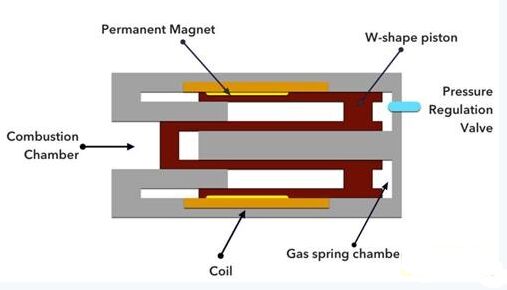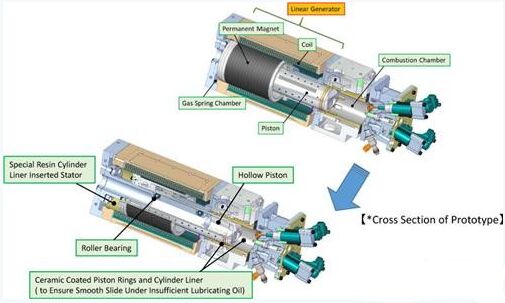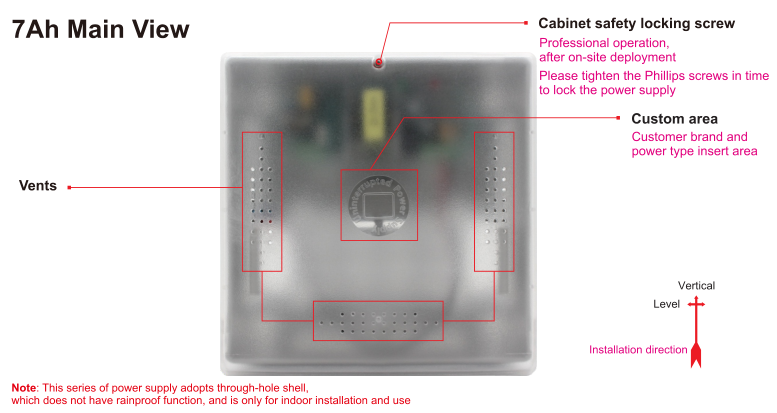The Toyota Central Research Institute is currently developing a Free Piston Engine Linear Generator (FPEG) with a maximum power of 20 kW. Toyota expects that one such motor can achieve a top speed of 120 km/h in another small or compact electric vehicle.
This article refers to the address: http://
The modified generator consists of a two-stroke combustion chamber, a linear generator, and a gas spring chamber. The piston is pushed by the pressure of the gas combustion, and the magnet attached to the piston moves together with the piston, and electromagnetic induction is generated between the coil and the externally surrounded coil during the movement, and the kinetic energy is successfully converted into electric energy.
Toyota researchers say that FPEG generators have high thermal efficiency, low frictional resistance and low vibration. Two basic designs are used, the first being the opposite structure of the combustion chamber and the second being a cooperative structure of a combustion chamber and a gas spring chamber.

The main structure of FPEG is a W-shaped hollow piston. The smaller diameter side of the piston constitutes the combustion chamber, and the larger diameter side forms the gas spring chamber. The burned exhaust gas is discharged from the exhaust valve of the cylinder head; fresh air is poured from the scavenging hole of the cylinder liner.
Part of the kinetic energy of the piston during movement is stored in the gas spring, and then the spring releases the kinetic energy while moving back. A magnet is attached to the outer edge of the piston, and the magnet and the stator coil generate an induced magnetic field force when the piston moves.
Toyota said that this W-type piston has several advantages. The larger the cross-sectional area of ​​the gas spring chamber, the lower the compression temperature in the spring chamber and therefore the lower the heat loss. The core of maintaining a stable and continuous operation of the FPEG motor is lubrication, cooling, and control logic.
The inner edge of the hollow piston can be reciprocated as a slide rail. The magnet that fits the piston is far from the top of the piston to prevent it from being de-energized when it encounters high temperatures.

FPEG engine generator structure
To verify the performance of this generator, the researchers used a one-dimensional cycle simulation method and used it to evaluate spark plug ignition (SI) and premixed compression ignition (PCCI). In both combustion modes, the motor output power can reach 10%, and the latter has a thermal efficiency of 42%.
The researchers also constructed a FPEG prototype using a one-way flow scavenging layout and a two-stroke spark plug ignition internal combustion engine system. Both the ring and the cylinder liner are ceramic coated so that the piston can slide back and forth smoothly even in the absence of lubrication. The poppet valve is located inside the water-cooled cylinder head and is driven by a hydraulic valve assembly to control the timing of the exhaust valve. The direct fuel injection process reduces emissions of incompletely combusted hydrocarbon emissions.
The use of a pressure regulating valve in the gas spring chamber allows the mass of the spring to be variable, which means that the stiffness of the gas spring is variable, making it adaptable to different operating conditions.
The linear generator can be regarded as a permanent magnet motor composed of a fixed coil, a magnet, and a core stator. The electric drive component acts as both a motor and a generator.
The researchers designed a prototype control system to ensure that the compression ratio is fixed, thus achieving stable operation of the system. The system's load factor is variable based on the position and speed of the piston.
There is no crank-link mechanism in this engine generator, so the position of the piston is not determined by the crankshaft phase angle as in conventional internal combustion engines. To determine the piston position, the Toyota researcher designed a number of grooves on the piston side surface and fitted a position sensor on the inner wall of the cylinder.
The generator control logic must meet the following requirements:
- In vehicle applications, multiple FPEG generators need to eliminate vibration during operation through a horizontally opposed layout; the vibration frequency and phase of the piston must be controllable.
- The top dead center and bottom dead center of the two-stroke internal combustion engine in the system must be precisely controlled to ensure stable operation of the engine.
During the experiment, the prototype FPEG generator was operated for 4 hours without any failure due to insufficient cooling and lubrication.
Experimental analysts pointed out that ignition timing also plays a crucial role in the stable operation of FPEG engine generators.
In future work, the research team plans to improve the power generation system and quantify the efficiency of the implementation.
Analysis.
- Plastic case power supply
- Battery over-charge, over-discharge protection
- Additional current battery charge
- Pro-wired battery connection
- Product description: Applicable to all types of Alarm monitoring systems, Access control systems, Building intercom systems
Input voltage: 100-240V AC @ 50/60Hz
Output voltage: 13.8V DC
Output current: 2A .3A. 5A
Charge current: 1.0A Max.
Ripple&Efficiency: <100mV / >80%
Recommended battery: 12V7Ah , 12V 17Ah

Plastic Boxed Access Control Power Supply
Access Control Power Supply, Boxed Power Supply UPS,Power Supply for access control system
Guangdong Steady Technology Co.LTD , https://www.steadysmps.com